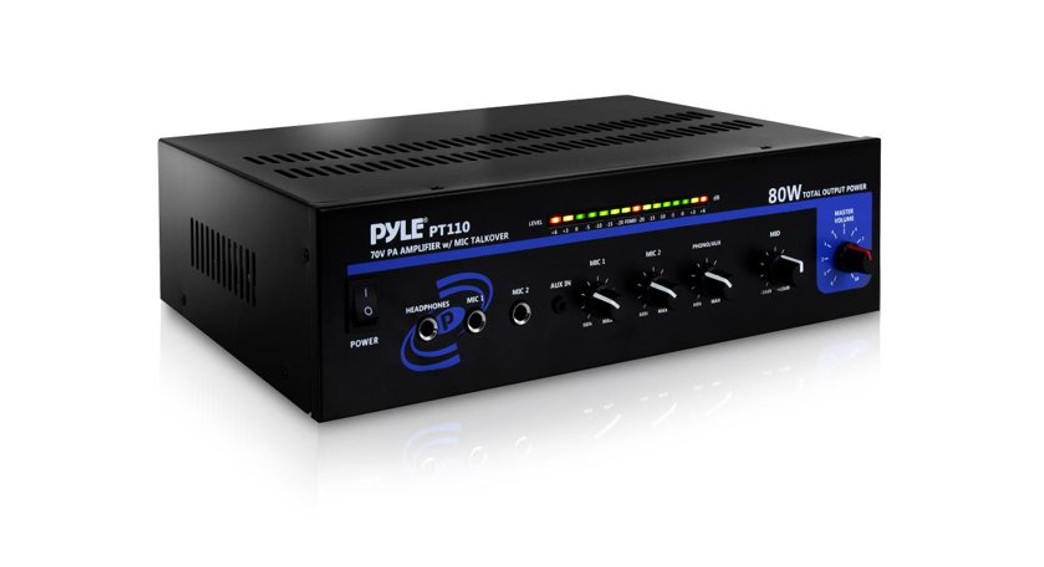
PT11080 Watt AC/DC MicrophonePA Mono Amplifier with USB/SD/FM/BTLED Level Display w/ 70V Output & Mic TalkoverUser Manual
INTRODUCTION
Your New PYLE PT110 PA AMPLIFIER gives you the power and versatility you need in a professional sound system. The amplifier’s wide frequency response makes it suitable for amplifying music or vocal program material. It can be used for live bands, office paging systems, public announcements, or a variety of other installations. Please read this manual thoroughly before you attempt to set up and use the amplifier. It contains a range of installation suggestions as well as instructions to ensure safe usage. Installed properly, you can expect years of trouble-free service from this product.
FEATURES AND CONTROLS
FRONT PANEL

REAR PANEL
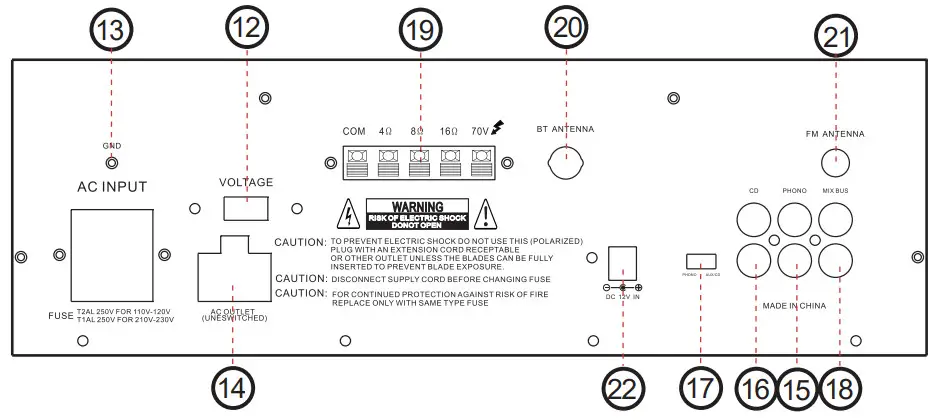
- POWER SWITCH: Press to switch the power unit ON or OFF.
- Phone Jack: Connect a pair of stereo headphones for private listening or cueing (monitoring) sound prior to “airing” it.
- MIC 1 & MIC 2 Jack: Allows you to connect up to two 6.35mm type microphone.
- LED Level Display Meter
- MIC Volume Control: This lets you adjust the MIC1/MIC2 sound level.
- Three Input Sources Mixing Controls: Controls the sound level for each of the audio input sources.PHONO/AUX: Select and connect an alternative high level (AUX/CD) or low level (PHONO) audio sound source.
- 100 Hz, 1 kHz, & 8 kHz Equalizer Controls: To enhance the sound or tailor the high, midrange, and low frequencies for each audio source input to the acoustics of a particular performance environment, you can adjust these equalizer tone controls.
- AUX Input Jack: This allows you to connect any high-level sound source, such as a CD player, tape deck, or tuner, to the CD/AUX jack.
- CONTROL PANEL BUTTONA. These buttons are only used to control the USB/SD, Wireless BT, and FM functions and don’t control other functions.B. MODE BUTTON: Press this button to select one from USB/SD mode, FM mode or Wireless BT play mode. USB/SD mode will be set automatically after turning ON the unit. Automatically plays mp3 files after inserting a USB flash drive or SD card. You cannot select AUX, CD, and DVD input on this button.C. Each press of the PLAY/PAUSE BUTTON causes the operation to change from play to pause or from pause to play in the USB/SD mode or Wireless BT mode.Press the PLAY/PAUSE BUTTON one time to auto-scan all frequencies from 87.5MHz to 108MHz in FM mode Press the button to auto-scan channels when you use FM radio for the first time. After stop searching, the unit will auto store all the radio channels and play from the first radio channel. You don’t need to rescan every FM radio startup.D. PREV and NEXT BUTTON: Use these two buttons to select the previous or next track, depending on these different modes as below.• In USB/SD mode: Use to select previous or next track.• In Wireless BT mode: Use to select previous or next track.• In FM mode: Use to select previous or next radio channel.
- LED Display: Show MP3/SD/BT/FM information.
- USB Port and SD card socket: After inserting a USB flash drive/SD Card into the input terminal, then press the mode button to choose between audio from the USB port, SD Card input, Wireless BT, or FM radio. If you want to use the Wireless BT, check the below steps.STEPS FOR CONNECTING WITH WIRELESS BT DEVICEA. Press the MODE button under the ID3 display screen and enter into BT mode.B. Search for the Wireless BT device and find the BT name “PYLEUSA or BT”C. Select the PYLEUSA or BT Wireless BT name and wait for the device to pair.D. The unit will make a sound confirming that the devices have successfully paired.E. Once paired you can play music from your bt device. You can also use the control buttons on the unit to select the tracks from your Bluetooth device.
- Voltage Switch: The amplifier has selectable input voltage from 110V/60Hz which is the standard in the USA and CANADA. You can also switch the input voltage to 220V/50Hz for EUROPEAN operation. Please make sure the switch is in the proper position before operating, otherwise severe damage will result not cover by the warranty. Please also replace the fuse with a proper rating in this situation (see the SPECIFICATIONS for the fuse rating).
- GND (GROUND) screw terminal: If you connect a low-level audio input source (turntable) to the PHONO, please connect your turntable’s ground wire (usually black or green) to the amplifier’s GND terminal, to avoid a low-frequency hum. You can also use this screw to ground any other system connection.
- Unswitched AC Accessory Outlet – 300W MAX.
- PHONO Input Jack: You can connect a low-level audio input source, such as a magnetic cartridge turntable to the L PHONO and R PHONO jacks.
- AUX/CD Input Jack: This allows you to connect any high-level sound source, such as a CD player, tape deck, or tuner, to the CD/AUX jack.
- PHONO and AUX/CD Input Selector: This lets you select the input source you want to connect to the amplifier.
- MIX BUS Jack: This allows you to connect another unit to this jack to double the size of your PA system.
- Push-Terminal Connectors: Let you easily connect speaker wires directly to the amplifiers.
- Wireless BT Anntena: Pull the antenna out when using Wireless BT input.
- FM Antenna: Pull the antenna when using FM input.
- DC 4A/12V Input Jack: This allows you to connect the power for the amplifier from a 12-volt battery source.
INSTALLATION GUIDELINES
- Input connections
- The Unit accept a broad range of input sources, including Microphones (up to two simultaneously)
- Compact Disc (CD) player
- Cassette, Reel-to-Reel or another tape player Radio Tuner
- Magnetic Cartridge Turntable
Connecting Microphones
The MIC 1 and MIC 2 jacks permit you to connect two microphones with 6.35mm plug.
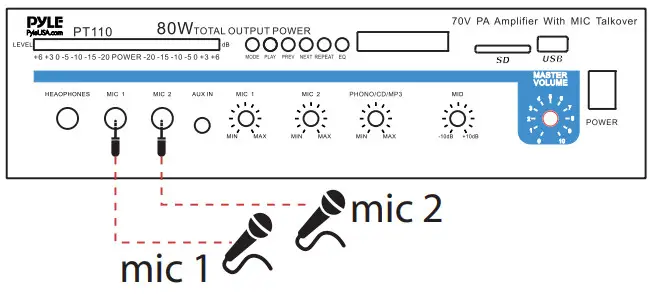
Connecting a CD or Tape Player, or TunerIn this situation, set the PHONO and AUX/CD SELECTOR switch to the AUX/CD
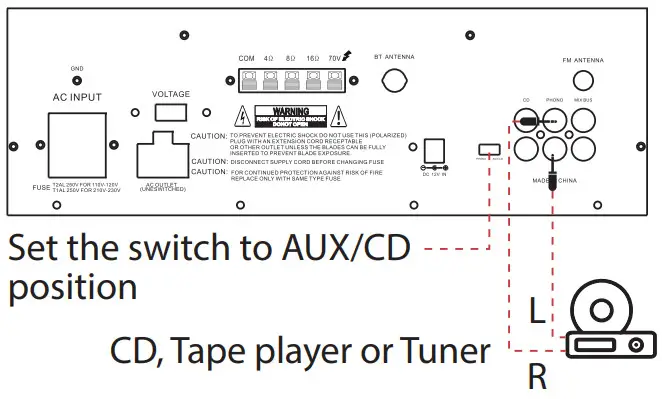
Connecting a TurntableIn this situation, set the PHONO and AUX/ CD SELECTOR switch to the PHONO.
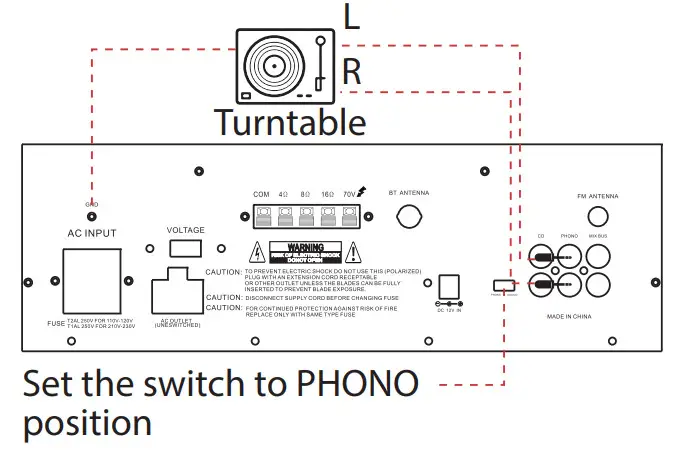
Speaker Connections
One or more speakers (4, 8, or 16-Ohm) speakers can be connected to the amplifier with or without transformers. However, before you connect any speaker to the amplifier, the total speaker impedance must be calculated in order to avoid damage to the amplifier. A total speaker impedance greater than 16 Ohms or less than 4 Ohms can cause this damage to occur. To begin with, in order to ensure equal volume from each speaker, all connected speakers should have the same impedance. A roper total impedance with the 4 to 16 Ohms range can be achieved by combining series and parallel speaker connections. Please see the diagrams which follow the same impedance. Finally, always use the shortest length of speaker wire possible of proper gauge. Usually, 18-gauge wire is adequate for lengths under 25 feet, while 16-gauge is used for greater lengths.
System 1: Single speaker system
- Connect the speaker (-) terminal to the amplifier COMMON terminal
- Depending on the speaker being used, connect the speaker (+) terminal to the amplier’s 4-Ohm, 8- Ohm or 16-Ohm amplifier terminal.

This example shows a 4 Ohm Speaker
System 2: Two (or more) speakers in series
- Connect the LEFT SPEAKER (-) to the amplifier COMMON terminal.
- Connect the LEFT SPEAKER (+) to the RIGHT SPEAKER (-).
- Connect the RIGHT SPEAKER (+) to the amplifier’s 4-Ohm, 8-Ohm, or 16-Ohm terminal, depending on the TOTAL IMPEDANCE of the two speakers. If each speaker has an impedance of 8 Ohms, the total speaker impedance in this series configuration is 16 Ohms.
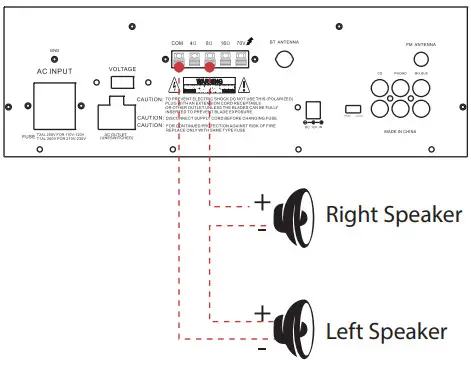
This example shows two 4 Ohm Speakers, the total impedance is 8 ohms.
NOTE: ADDITIONAL SPEAKERS MAY BE INCLUDED IN THE SERIES, BUT IT IS NECESSARY TO CALCULATE TOTAL IMPEDANCE AND CONNECT THE SPEAKER CIRCUIT TO A TERMINAL OF APPRO- PRIATE IMPEDANCE. FOR EXAMPLE, IF THREE SPEAKERS OF 4-OHM ARE USED, THE TOTAL IMPEDANCE IS 12 OHMS, YOU SHOULD CONNECT TO THE 16-OHM TERMINAL.
System 3: Two (or more) speakers in parallel
- Connect the LEFT SPEAKER (-) to the RIGHT SPEAKER (-).
- Connect BOTH the LEFT SPEAKER (-) and the RIGHT SPEAKER (-) to the amplifier COMMON terminal.
- Connect the LEFT SPEAKER (+) to the RIGHT SPEAKER (+).
- Connect BOTH the LEFT SPEAKER (+) and RIGHT SPEAKER (+) to the amplifier 4-Ohm, 8-Ohm, or 16-Ohm terminal, depending on the TOTAL IMPEDANCE of the two speakers. If each speaker has an impedance of 8-Ohm, the total speaker impedance in this parallel configuration is 4 Ohms.
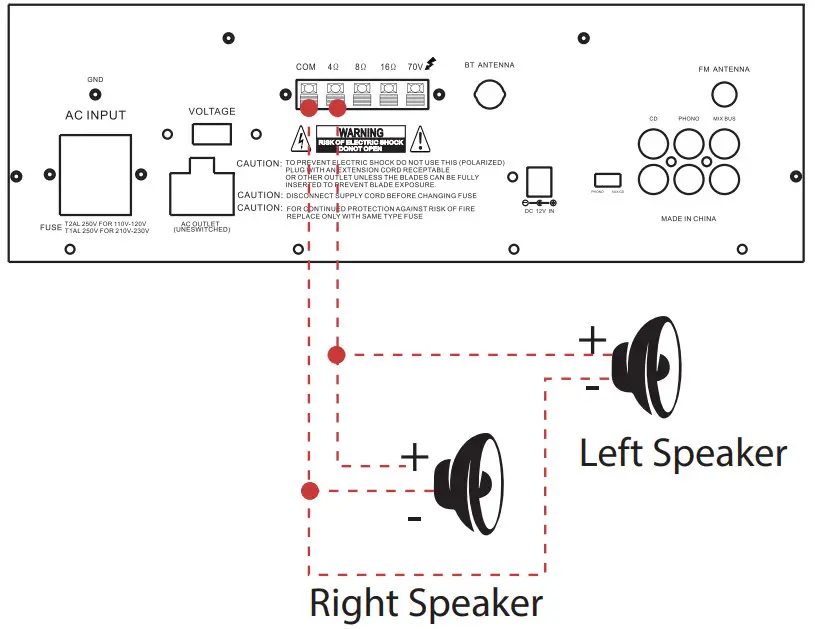 This example shows two 8 Ohm Speakers, the total impedance is 4 ohms.
This example shows two 8 Ohm Speakers, the total impedance is 4 ohms.
System 4: Four speakers in series/parallel combination
- Group the four speakers into two pairs.
- Connect each pair of speakers in SERIES (see system 2 above). If you connect 8-ohm speakers, the total impedance of each pair is 16 ohms.
- Connect the two pairs of speakers in PARALLEL. If you connect 8-ohm speakers, the total impedance of both pairs is 8 ohms.Note:If each of the four speakers is 8 ohms, the total speaker impedance of the combined series/parallel connection described above is also 8 ohms. Likewise, the total speaker impedance is 4 or 16 ohms, if the speakers are 4 or 16 ohms respectively.
- Connect the speakers’ (-) terminals to the amplifier’s COMMON terminal.
- Connect the speakers’ (+) terminals to the amplifier’s 4-Ohm, 8-Ohm, or 16-Ohm terminal, depending on the TOTAL IMPEDANCE of the FOUR SPEAKERS.
See the chart below for some samples system suggestions:
| SERIESTO EACH PAIR(net impedance) | PARALLELTO TWO PAIRS(net impedance) | TOTALIMPEDANCEIN THIS TYPE | Use thisampTermine |
| 4-OHM + 4-OHM(8 OHMS) | 8-OHM + 8-OHM(4 OHMS) | 4-OHM | 4-OHM |
| 8-OHM + 8-OHM(16 OHMS) | 16-OHM + 16-OHM(8 OHMS) | 8-OHM | 8-OHM |
| 16-OHM +16-OHM(32 OHMS) | 32-OHM + 32-OHM(16 OHMS) | 16-OHM | 16-OHM |

This example shows four 8 Ohm Speakers, the total impedance is 8 ohms.
SERIES/PARALLEL VARIATIONS
Although the description above is for combining TWO SERIES PAIRS in a PARALLEL hook up, you may also select to combine a SERIES PAIR and a PARALLEL PAIR in a PARALLEL hook up. Simply be sure you have properly calculated the total impedance, and connect the (+) speaker circuit wire to the proper amp terminal. For example, if you use a SERIES PAIR of 8-Ohms speakers (the total impedance is 16 ohms) and a PARALLEL PAIR of 8-Ohms speakers (the total impedance is 4 ohms) in a PARALLEL hook up, the TOTAL IMPEDANCE of this system is 3.2 OHMS, so you should connect the (+) speaker circuit wire to the 4-OHM terminal.
See the chart below for some samples system suggestions:COMBINATION OF ONE SERIES PAIR AND ONE PARALLEL PAIR IN PARALLEL
| SERIES TO ONESPEAKER PAIR(net impedance) | PARALLEL TO ONE SPEAKER PAIR(net impedance) | TOTAL IMPEDANCECOMBINING TWOPAIRS IN PARALLEL | Use thisampterminal |
| 8-OHM + 8-OHM(16 OHMS) | 8-OHM + 8-OHM(4 OHMS) | 3.2 OHMS | 4-OHM |
| 16-OHM + 16-OHM(32 OHMS) | 8-OHM + 8 OHM(4 OHMS) | 3.6 OHMS | 4-OHM |
| 4-OHM + 4-OHM(8 OHMS) | 16-OHM + 16-OHM(8 OHMS) | 4.0 OHMS | 4-OHM |
| 8-OHM + 8-OHM(16 OHMS) | 16-OHM + 16-OHM(8 OHMS) | 5.3 OHMS | 8-OHM |
 Four 8 Ohm Speakers
Four 8 Ohm Speakers
System 5: Connecting speakers with transformers
- Locate the input taps on your transformer. These taps are on side of the transformer and are rated in watts, 10, 5, 2.5, 1.25, or 0.62. Usually, each speaker in a system uses the same wattage tap. Connect the selected tap to the amplifier 70V RMS terminal. If you wish a particular speaker to have a higher volume level, connect the wire from 70V RMS to a higher wattage tap on the transformer.
- Connect the transformer’s COMMON tap on the primary side to the amplifier COMMON terminal.
- Connect the speaker’s (+) terminals to the transformer’s secondary tap that matches the speaker’s TOTAL IMPEDANCE. Locate on the opposite side of the transformer, these secondary taps are outputs, and are rated in Ohms 4, 8, or 16.
- Connect the speaker’s (-) terminals to the transformer’s COMMON tap on the secondary side.
NOTE:
- Before connecting the speakers, please be sure the total wattage of the primary tap you use does not exceed the amplifier’s maximum power rating, PT110 20W, and PT210 40W.
- Avoid, where possible, multiple connections to the 70V RMS and COMMON terminals.
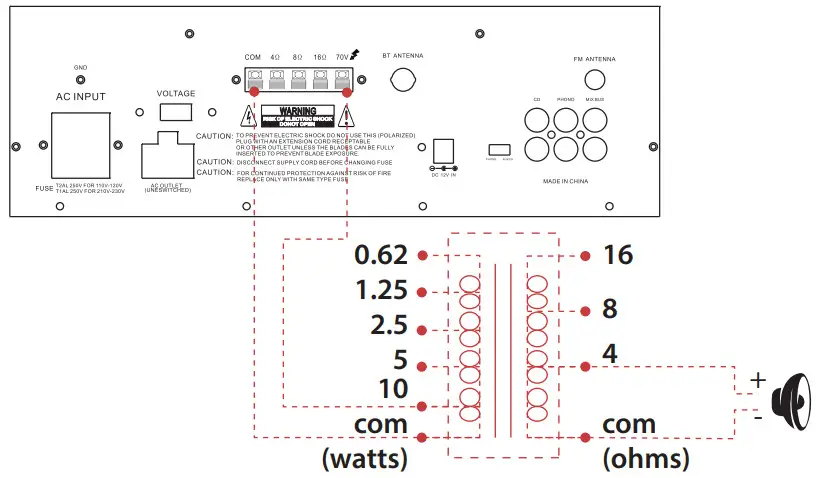
Using Headphones
To listen privately, or to monitor sound sources, connect a pair of low impedance stereo headphones (not supplied) with 6.35mm plug into the PHONES jack on the amplifier front panel.
Please listen safely. Follow these recommendations:Do not listen to extremely high volume levels. Extended, high-volume listening can lead to permanent hearing loss. Always start with the volume control set to a LOW level BEFORE you put the headphones on. Then gradually increase the volume as necessary.
Connecting to standard AC powerAfter making all other connections, set the POWER switch to the OFF position. Then connect the power cord to a standard AC outlet.Connecting to 4A/12V DC powerYou can power the amplifier from your vehicle’s 12-volt battery. Connect the supplied DC power cable’s barrel plug to DC 12V IN jack on the amplifier, and then connect the cable’s other end to the 12-volt accessory socket on the vehicle, such as the cigarette-lighter socket.
CAUTIONS:PLEASE UNPLUG THE AC POWER CORD BEFORE CONNECTING THE DC POWER CABLE FOR THIS 12V POWER USAGE, AND DISCONNECT THE DC POWER CABLE BEFORE PLUGGING IN THE AC POWER CORD FOR AC POWER USAGE. THE VEHICLE USING THIS POWER SOURCE MUST HAVE A NEGATIVE GROUNDELECTRICAL SYSTEM. IF YOU ARE NOT SURE OF IT, PLEASE CHECK WITH YOUR VEHICLE’S DEALER.
Turning the amplifier ON
- Turn on the audio input source equipment which is connected to the amplifier INPUT jack.
- Set all volume levels (MASTER, MIC 1, MIC 2, and PHONO/AUX) to their minimum level settings.
- Press the power switch to turn the amplifier on.
- Adjust the controls of MIC 1, MIC 2, and PHONO/AUX to the achieve desired volume and balance. Using the LED power meter The meter LED position indicates the amplifier output power.
Using the MASTER volume controlThe MASTER volume control increases or decreases output level gain. To obtain the best performance with the least distortion, be sure to adjust the output level so that the LED meter does not continually exceed the right extreme of the meter’s range.
CAUTION: Setting output levels too high can overdrive the amplifier, causing permanent damage.Using the MIX BUS jackYou can connect another PT110/ PT210 to this jack to double the size of your PA system. This lets you use up to four microphones and two turntables (or two auxiliaries) sound sources. Use a shielded cable with phono plugs at each end, and connect the cable between the MIX BUS jacks on the back of two amplifiers.For the best results, do not use a cable longer than 6 feet.

Remote control

- Press this button to turn ON or OFF the MP3.
- When in the FM mode, press these two buttons to tune FM Frequency.
- Press these two buttons to select the previous or next track in USB or SD or Wireless BT mode, to select the previous or next channel in the FM model.
- Volume up or down
- Press the numbers to select the tracks directly. The unit takes 1-2 seconds to respond in USB or SD mode.
- Press this button to repeat mode.
- Press this button to select the playing mode, such as USB/SD/FM/WIRELESS BT
- EQ function: Select a pre-set mode of the equalizer that is designed accordingly.
- Play and Pause function for MP3 in USB/SD/BT model. Press this button to auto scan the channel in the FM model, and auto store the channel.
Features:
| • 1/4” Phone Jack | • Mic 1 Mic 2 6.35mm Connectors |
| • LED Level Display | • Removable AC Cord |
| • Master Volume Control | • Unswitched AC Outlet |
| • Tone Control | • Phono/Aux/RCA Input Jacks |
| • Mix Bus Jacks | • Phono/Aux Input Selector |
| • Front 3.5mm AUX CD Input Jack | • Variety of Speaker Outputs Terminal |
| • MIC 1/MIC 2 Talkover | • USB/SD/FM/ LED Display & Wireless BT Features |
| • DC 12V Inlet | • Includes Wireless BT Antenna to Improve BT Distance |
| • Phono/Aux Volume Control | • Includes FM Antenna to Improve FM Sensitivity |
| • Mic 1 Mic 2 Volume Controls |
Wireless BT Connectivity:
- Simple & Hassle-Free Pairing Ability
- Works with All of Today’s Latest Devices (Smartphones, Tablets, Laptops, Computers, etc.)
- Wireless BT Network Name: ‘PYLEUSA’
- Wireless BT Version: 5.0
- Wireless Range: 40’ + ft.
What’s in the Box:
- PA Microphone Mono Amplier
- Remote Control
- FM Antenna
Technical Specs:
- Power Supply: 80 Watt
- Power Output: 70V
- Voltage Selector: 120/240V
- Construction Material: Iron
- Frequency Response: 50Hz – 20kHz
- Battery Operated Remote, Requires (1) x CR-2025 Button Cell Battery, Included
- Impedance: 4 Ohm, 8 Ohm, 10 Ohm, 70V
- Product Dimension (L x W x H): 12.6’’ x 10’’ x 3.75’’ -inches
 WARNING
WARNING

 VISIT US ONLINE:Have a question?Need service or repair?Want to leave a comment?PyleUSA.com/ContactUsQuestions? Issues?We are here to help!Phone: (1) 718-535-1800Email: [email protected]
VISIT US ONLINE:Have a question?Need service or repair?Want to leave a comment?PyleUSA.com/ContactUsQuestions? Issues?We are here to help!Phone: (1) 718-535-1800Email: [email protected]References
[xyz-ips snippet=”download-snippet”]

